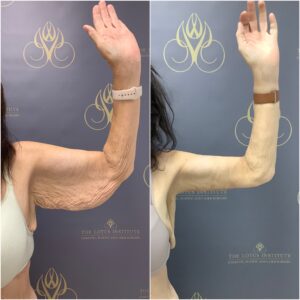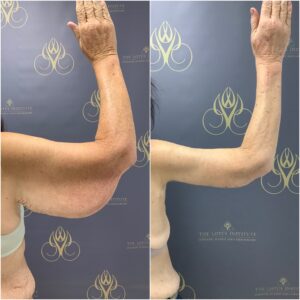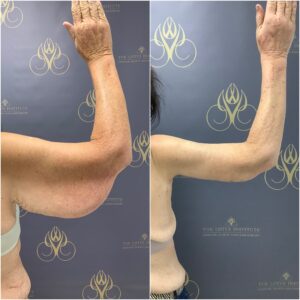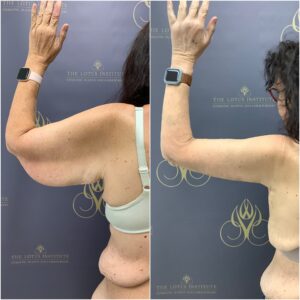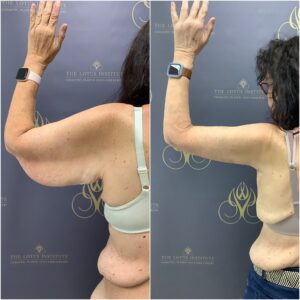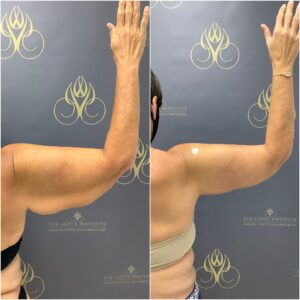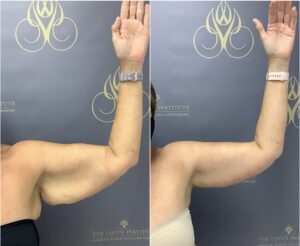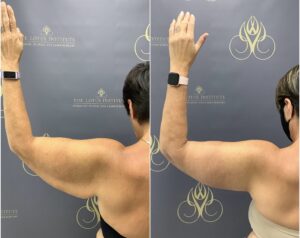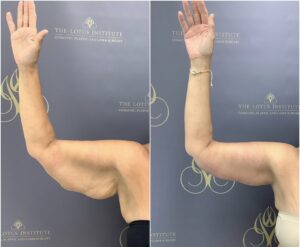
Brachioplasty (Arm lift)
A brachioplasty, commonly known as an arm lift, is a surgical procedure designed to improve the contour and appearance of the upper arms. It involves the removal of excess skin and fat from the upper arms, which may result from significant weight loss, ageing, or genetic factors. The procedure tightens and smoothes the underlying supportive tissue and reduces localised pockets of fat, leading to a more proportionate arm appearance.
Who is a good a candidate for a brachioplasty?



A patient may choose to discuss brachioplasty if they have excess skin on the upper arms due to aging, weight loss, or other factors.
Stable Weight
Brachioplasty (Arm lift): The Procedure
How is a brachioplasty performed?
A brachioplasty, or arm lift, is a surgical procedure designed to improve the appearance of the upper arms by removing excess skin and fat. Here is a summary of how the procedure is typically performed:
Anaesthesia
The procedure begins with the administration of a general anaesthesia in a fully certified hospital.
Incision
The surgeon makes an incision on the inside or back of the upper arm. The length and pattern of the incision depend on the amount and location of excess skin to be removed. In some cases, a minimal incision may be made near the armpit.
Tissue Removal and Contouring
Excess skin and fat are removed from the upper arm. The underlying supportive tissue is tightened and reshaped to improve the contour of the arm. Liposuction may also be used to remove excess fat.
Closing the Incision
The remaining skin is smoothed over the new contours of the arm, and the incision is closed with sutures. Surgical dressings are applied to the incisions to support the healing process.
Recovery & Aftercare
You will usually be discharged home from hospital the same day. You are required to have someone pick you up from the hospital and remain with you for the first 24hours. You will be placed in a surgical bra which is to be worn at all times for the first 6weeks. Surgical garments provide compression to the site and assist in reducing swelling and support healing.
Patients are monitored in the surgical recovery room at the hospital immediately after their operation. Patient’s usually go home on the same day. Swelling and bruising are normal and usually peak within the first few days.
Prescribed pain medication helps manage discomfort during the recovery phase.
You will have an initial review with our nurse during the first post-operative week, and at each week until your incisions are healed and your pain has resolved. 6 weeks post-operatively you will have a review with Dr Cronin. Regular follow -ups with Dr Cronin at 3months, 6 months and 12months are also essential to monitor your surgical outcome.
Patients should avoid strenuous activities and heavy lifting for 4-6 weeks. Light activities can typically be resumed within a week. Dr Cronin or our nurse will advise you if it is safe to resume exercise.
Patients are advised on proper scar care techniques to minimise scarring. We offer a scar treatment plan as an add on to their procedure for all surgical patients.


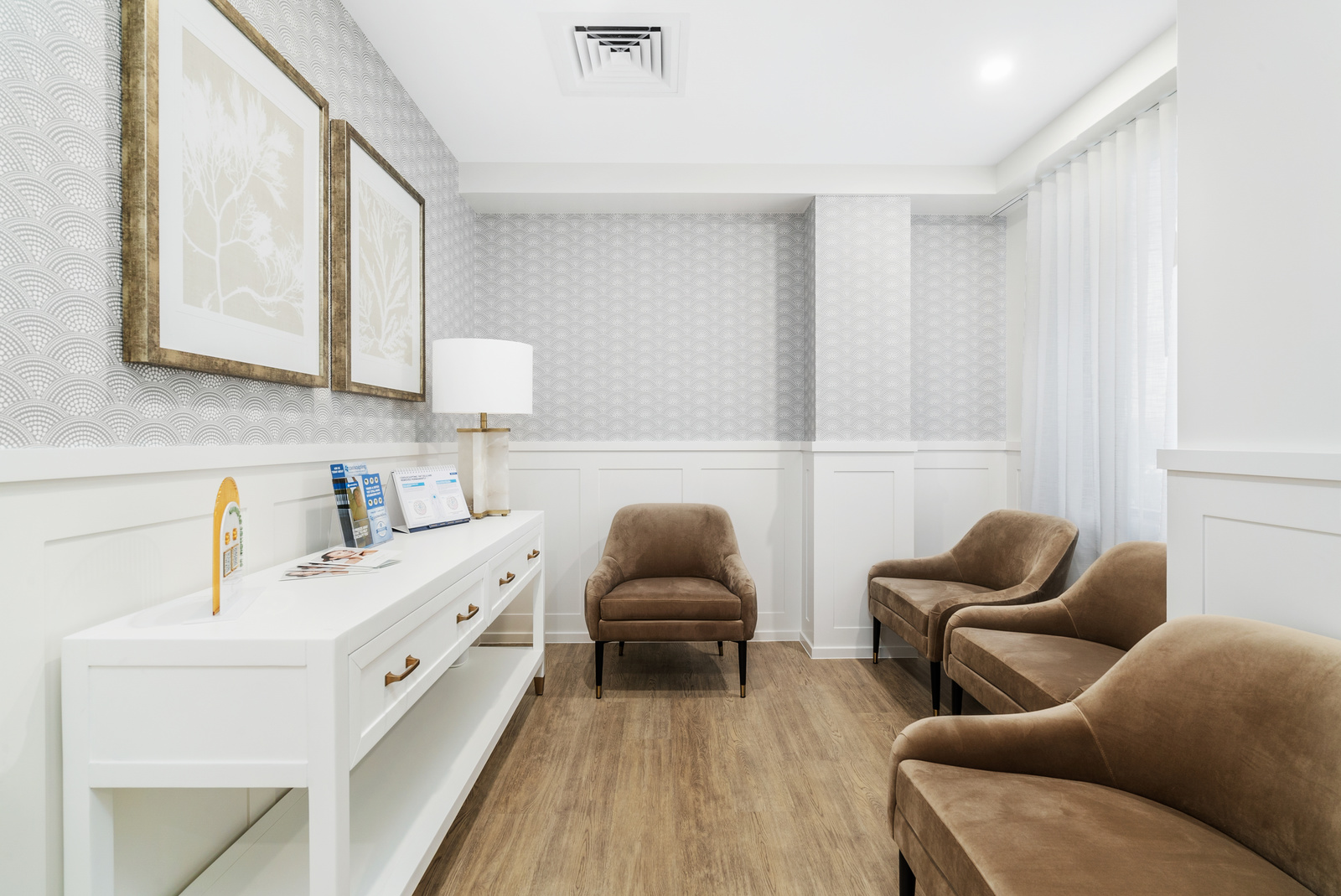
Brachioplasty Before and After Gallery
Individual results will vary from patient to patient and according to factors including genetics, age, diet, exercise. All invasive surgery carries risk and requires a recovery period and care regime. Be sure you do your research and seek a second opinion from an appropriately qualified Specialist Plastic Surgeon before proceeding. Any details are general in nature and are not intended to be medical advice or constitute a doctor-patient relationship.
For comprehensive information on the potential risks and post-surgery recovery process, please see risks associated with surgery section towards the bottom of this page.
Frequently Asked Questions
If we haven’t addressed your inquiries yet, here are some frequently asked questions that may provide the information you’re looking for. However, if you still have any remaining questions or concerns, please don’t hesitate to reach out to our clinic at 07 5683 0820 or via email at admin@thecoastalclinic.com.au. Our team is ready to assist you.
–
As a single procedure, an arm lift or brachioplasty is performed as a day procedure and no overnight stay is required.
An arm lift (brachioplasty) is generally considered a medical procedure and is typically covered by Medicare in Australia. If excess skin is causing significant medical issues such as chronic rashes, infections, or other health problems that cannot be managed by non-surgical means, Medicare will provide partial coverage, however there will still be an out of pocket cost for the patient.
It is to be expected that there will be scars after an arm lift surgery (brachioplasty). The extent and visibility of the scars depends on the surgical technique used, the amount of skin removed, and individual healing. Typically the scar will run from the elbow to the armpit.
We offer all surgical patients a scar treatment plan at our Varsity Lakes Aesthetics clinic. The treatment plan has been designed based on clinical evidence to improve the healing of scars.
–
After an arm lift (brachioplasty), most patients can resume normal daily activities within about 2 to 3 weeks, although this timeline can vary based on individual healing rates and the extent of the surgery. Light activities and non-strenuous tasks can typically be resumed sooner, usually within a few days to a week. However, patients are advised to avoid heavy lifting, strenuous exercise, and activities that strain the arms for at least 4 to 6 weeks to ensure proper healing and prevent complications. Always follow Dr Cronin’s specific post-operative guidelines and attend follow-up appointments to monitor recovery progress.
After an arm lift (brachioplasty), patients may experience temporary changes in arm sensation, such as numbness, tingling, or altered sensitivity in the upper arms. These sensations are common and typically result from nerve disruption during surgery. In most cases, these changes gradually improve as the nerves heal over several weeks to months. However, in rare instances, some residual changes in sensation may persist. It is important for patients to discuss any concerns with their surgeon during follow-up appointments to ensure proper monitoring and care.
Yes you will require a referral from you general practitioner (GP) to Dr Cronin. Please email your referral through to admin@thecoastalclinic.com.au before your consult with Dr Cronin.
Yes, brachioplasty can be combined with other surgical procedures.
It’s not uncommon to pair an arm lift with liposuction, a body lift or a posterior upper body lift (bra line back lift).
Risks of Surgery
As part of our commitment to delivering exceptional patient care, we aim to provide you with comprehensive information regarding the general risks associated with surgical procedures, anaesthesia, and procedure-specific risks.
- Acute medical event: Heart or lung complications (e.g. heart attack, stroke, chest infection)
- Death
- Deep Vein Thrombosis (DVT) or Pulmonary Embolisms (PE)
- A sore throat/breathing difficulty due to the general aesthetic or the endotracheal tube, which can cause swelling, noisy breathing or discomfort
- Short-term nausea following general anaesthesia
- Wound infection, which may result in treatment with antibiotics or further treatment/surgery. This is more likely in a smoker or a person with diabetes.
- Heavy bleeding from the wound, which may result in further treatment/surgery
- Wound discharge
- Poor or slow healing of the skin; wound breakdown; skin necrosis
- Wound dehiscence (wound ruptures along the surgical incision)
- Bruising and swelling. This will start to subside in one to two weeks but can take up to several months to settle
- Abscess/Haematoma/Seroma/Oedema
- Pain and discomfort
- Allergic reaction to sutures, dressing, antiseptic solutions
- Altered or loss of sensation in and around the treated area, which may persist for some months, numbness maybe permanent
- Adverse scarring
- Revisionary surgery
- Psychological impact of change in appearance
- Unsatisfactory cosmetic appearance
Puckering at wound edges
Paraesthesia (may be numbness or tingling)
Swelling of hand or forearm
- Acute medical event: Heart or lung complications (e.g. heart attack, stroke, chest infection)
- Death
- Deep Vein Thrombosis (DVT) or Pulmonary Embolisms (PE)
- A sore throat/breathing difficulty due to the general aesthetic or the endotracheal tube, which can cause swelling, noisy breathing or discomfort
- Short-term nausea following general anaesthesia
- Wound infection, which may result in treatment with antibiotics or further treatment/surgery. This is more likely in a smoker or a person with diabetes.
- Heavy bleeding from the wound, which may result in further treatment/surgery
- Wound discharge
- Poor or slow healing of the skin; wound breakdown; skin necrosis
- Wound dehiscence (wound ruptures along the surgical incision)
- Bruising and swelling. This will start to subside in one to two weeks but can take up to several months to settle
- Abscess/Haematoma/Seroma/Oedema
- Pain and discomfort
- Allergic reaction to sutures, dressing, antiseptic solutions
- Altered or loss of sensation in and around the treated area, which may persist for some months, numbness maybe permanent
- Adverse scarring
- Revisionary surgery
- Psychological impact of change in appearance
- Unsatisfactory cosmetic appearance





